The Women in Law Initiative founder, Nida Usman Chaudhary presented the findings of her supplementary report on the ‘State of Women’s Representation in Judiciary’ at the online report launch on Wednesday, January 24, 2024 in Lahore.
The session was hosted by Aliza Masood Reza who is a lawyer and an active volunteer at Women in Law Initiative Pakistan. She introduced the significance of releasing the report on this day and said that “This day holds the significance of being the ‘Day of Women’s Representation in the Supreme Court of Pakistan’ as the first female justice of the supreme court of Pakistan, Hon’ble Mrs. Justice Ayesha A. Malik took oath on this day two years ago in 2022. Since then, Women in Law Initiative has marked this date to celebrate and take stock of the progress made re women’s representation in justice sector since then.”
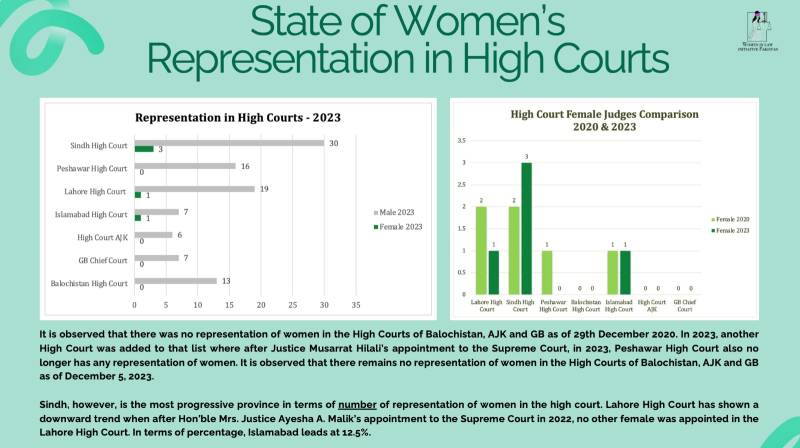
While commenting on the significance of this day, the author of the report and founder Women in Law Initiative Pakistan, Nida Usman said, “Day of Representation of Women in Supreme Court is an important reminder that such milestones need to be remembered and celebrated to keep our herstories alive and to continue to give ourselves an opportunity to reflect and take stock of how far we have come each day since. Being mindful of the first moment the ceiling was shattered and to use that as the baseline for tracing progress is fundamental for keeping track of progression or regression in this sector and for all these reasons this day holds incredible power and significance for me and the work we do.”
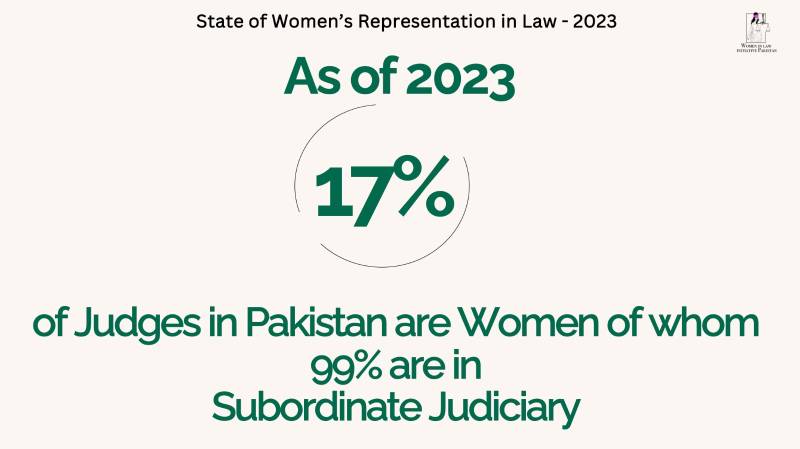
The supplementary report focuses on state of representation of women in judiciary as of 2023. By compiling and presenting such data, the report aims to highlight the gender parity gap in judiciary as well as to take stock of any progress from the baseline report that was published in the year 2020-21 as part of ‘increasing women’s representation in law’ – a collaborative project between Federal Ministry of Law and Justice, Group Development Pakistan & Women in Law Initiative Pakistan with support from the Australian High Commission and the British High Commission.
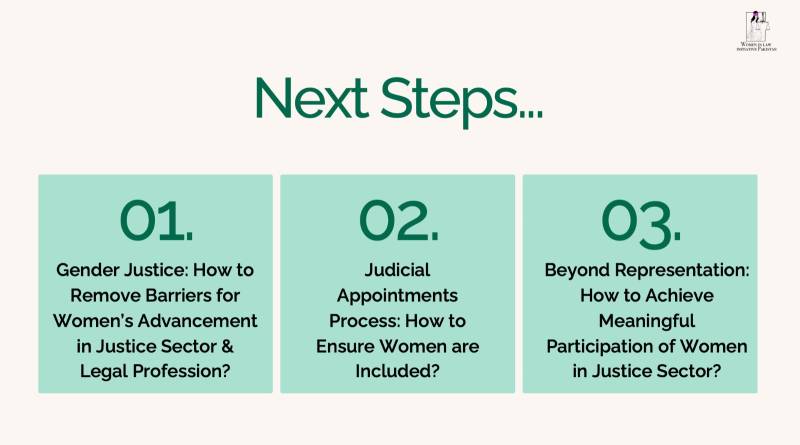
The data presented in this edition encompasses a province-wise breakdown and a tier-wise gender-segregated analysis, presented through tables and charts. The objective is to quantitatively showcase the existing gender disparity across judiciary. For the purposes of determining the total number of judges only the values for Civil Judges, Senior Civil Judges, Additional District and Sessions Judges, District and Sessions Judges, High Court Judges, Federal Shariat Court and Supreme Court Judges have been used. The author was supported by Yasir Abbas, Tayaba Kakar and Kanza Chaudhary in the completion and compilation of this report.
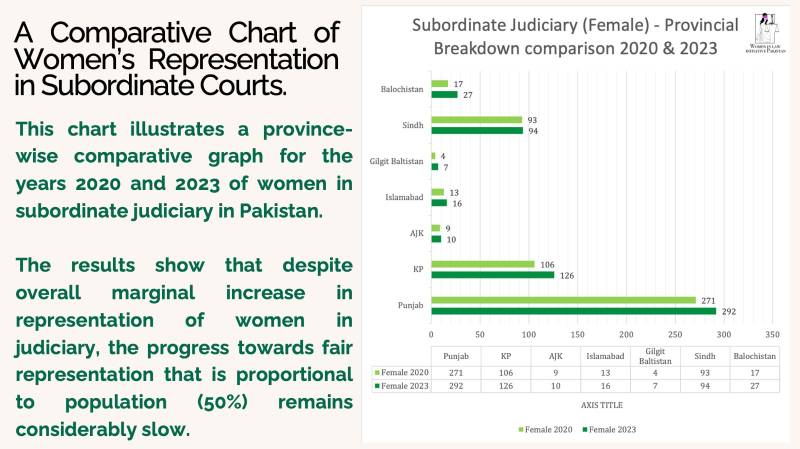
The results show that majority of women judges form part of the subordinate judiciary where recruitment is via competitive examination whereas negligible number of women reach higher judiciary as the system of judicial appointments in higher courts is based on discretionary nominations. It also shows that overall, there has been a minimal increase in the percentage of women in higher courts from 1.1% in 2020 to 1.2 % in 2023 vis a vis women inter-se.
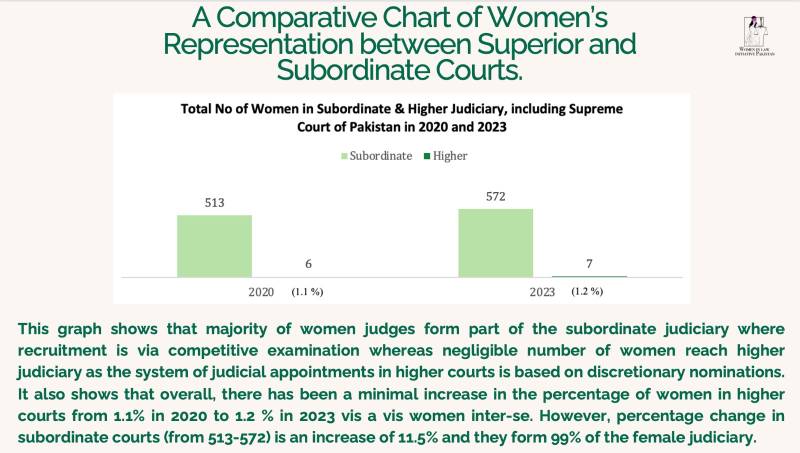
However, percentage change in subordinate courts (from 513-572) is an increase of 11.5% and they form 99% of the female judiciary. In 2023, only 6% of the judges at the superior courts are women which shows a minimal increase of barely one additional percent from the baseline year of 2020. Sindh leads in numbers, with three female judges in their high court, followed by one in Lahore and one female in Islamabad High Court. In no other high courts of the country are women currently represented as judges.
The state of women’s representation in the subordinate judiciary is comparatively much better than at the superior tier. In 2023, women make up 99% of the 17% of the judiciary with Khyber Pakhtunkhwa leading by ensuring 25% representation of female judges in its subordinate courts.
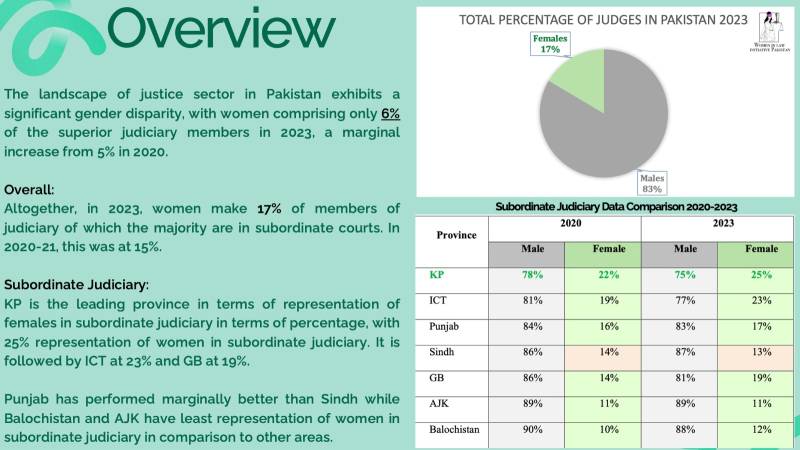
It is important to highlight that the process of recruiting judges in the subordinate courts is significantly different than the nominations and appointments process of the higher courts, in that, at the subordinate level, it is based on a competitive examination and recruitments are made in accordance with Judicial Service Rules of the province.
Nida urged that, “the regulators and concerned bodies must recognize the ground disparities and structural barriers that hinder women’s access and advancement in the justice sector to take a leading role in introducing necessary reforms for a diverse and inclusive legal system that enhances the stature of the profession on the diversity and inclusion index.”
The session was attended by legal professionals, members from academia, prominent journalists, activists, and students from law colleges.







